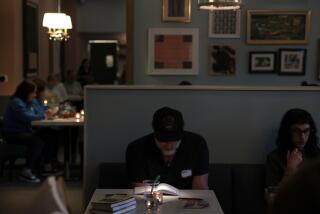Colette’s Paris
- Share via
Reporting from Paris — A frizzy-haired old woman wearing sandals used to sit on a stoop at the Palais-Royal in Paris. If people took her for a tramp, what did she care? Her extraordinary life was almost over. Now she could spend her afternoons eyeing passersby and cooing at stray cats.
Her ghost still haunts the quiet northern arcade of the Palais-Royal. Only now there’s a plaque to identify her: Colette, the extraordinary French writer who spent her last years at the edge of this garden. It doesn’t list dates; vain to the last, she wouldn’t have liked that. When she died at age 81 in 1954, she received a state funeral in the palace’s cour d’honneur. Her coffin, surrounded by wreaths, lay under a French tricolor, and thousands came to pay their respects.
Colette has gone in and out of style, but by any measure, she was a great writer, the author of 80 books, including novels about the insouciant teenage girl Claudine that became French bestsellers, inspiring two plays, a shirt collar, perfume, candy and cigarettes. Ten of her works have been made into films, most recently “Chéri,” with Michelle Pfeiffer in 2009, most famously the musical “Gigi” in 1958.
And then there was Colette, the woman, whose life arced across one of the most fascinating periods in French history, from the ebullient belle époque to the German Occupation and slightly beyond. For half a century, she scandalized Paris, lopping off her long schoolgirl braid and varnishing her toenails, gallivanting around town in an apparent ménage à trois with her husband and his girlfriend, cross-dressing for her lesbian lover, baring her breast onstage, divorcing, remarrying and seducing her teenage stepson.
Whenever she hit rock bottom, Colette remade herself, resulting in a resumé that reads like the Yellow Pages: journalist, critic, pornographer, music hall performer, lecturer, screenwriter, advice columnist, beautician (though her aging looks were no advertisement for her skills).
A naturally liberated woman, Colette despised feminists. She ate gluttonously and got fat; loved animals but monstrously ignored her only daughter; saved her third husband, who was Jewish, from World War II concentration camps while earning a living writing for the Nazi-controlled press.
Seemingly every insult you can throw at Colette sticks. In spite — or maybe because — of that, she earned plaques that mark her passage all over France.
I found the one at the Palais-Royal by chance a few years ago when I was living in Paris, then started reading her work, which was a revelation to me. In her best books — “The Pure and the Impure,” “The Cat,” “The Ripening Seed” — she probed the perversities of the human heart with the minimalist delicacy of a poet and a discriminating contrarianism I’ve come to think of as essentially French.
“Secrets of the Flesh,” Judith Thurman’s masterful 1999 biography, gave me the facts of Colette’s life, to which I recently added a little tourism, my own way of understanding things I care about. On several recent trips to France, I tried to raise Colette’s ghost by following in her footsteps, the first of them taken in a Burgundy village about 100 miles southeast of Paris.
Saint-Sauveur-en-Puisaye is a stonily silent town of about 950 people, slightly north of Burgundy wine country. It has only a pizzeria and a bed-and-breakfast to accommodate visitors. Most come not for Colette but to see nearby Guédelon, where a re-creation of a medieval castle is being built by hand using 13th century techniques.
When I reached the village, the streets were empty except for three children, whom I asked for directions. They huddled for a minute, then led me to the inn on their bikes. Maison Marthe is a cozy, idiosyncratic place with three guest rooms at the top of a narrow, winding staircase, decorated with French bric-a-brac. It occupies an 18th century row house overlooking the countryside.
Colette called the region “poor Burgundy.” But it has wide-open fields, forests, lakes and other charms she well knew and rendered in two beautiful memoirs. “Sido” and “My Mother’s House” are thus recommended reading for Colette pilgrims, glowing recollections of a seamlessly happy childhood and the woman who gave it to her.
Her mother, Sidonie, known as Sido, was a propertied widow, a good French bourgeoise by all appearances with two children. But the heart of a bohemian beat inside her corset. She married for love the second time, choosing the quiet oddball Jules-Joseph Colette, a veteran who lost a leg in one of Napoleon III’s wars.
Their youngest child, Sidonie-Gabrielle, was born in 1873 and raised with encompassing love and surprising license. She was left free to roam in the woods, tag along after her two older brothers, play with a pack of friends in the ruined château at the top of the village and take down books by Honoré de Balzac and Émile Zola from the top shelves to be devoured with the imperfect understanding of a prepubescent girl.
Empty and for sale when I saw it, the family home on Rue de l’Hospice (now Rue Colette) has battened-up shutters and a dour stone façade. As the writer recalled, it “smiled only on its garden side” in back, where the little girl nested in the grass while her mother gardened.
A passage from “My Mother’s House” made Colette’s childhood vivid to me. In it, the writer recalled getting to move from her cubbyhole upstairs near Sido’s bedroom to a chamber downstairs. Late one night, consumed with worry about being separated by a flight of steps from her cherished daughter, Sido carried the sleeping child back upstairs. Colette woke the next morning in her old bed, and, confused, ran to tell her mother that she had been abducted.
The village also evokes Colette’s alter ego: wicked and wonderful Claudine from a Saint-Sauveur known as Montigny in the books, where she attended a school full of precocious Lolitas, run by a lesbian headmistress. In its prototype (now the town hall), I saw the classroom where the writer studied geography, learned to sew and pulled pranks.
Apart from the books, the best place to get to know the writer is at the Colette Museum in a 17th century château on the hill above town. Its thoughtfully designed galleries contain art, photos and memorabilia that any Colette fan would consider treasures: the Palais-Royal bedroom suite where the invalid writer spent her last years; posters from her music hall career; pictures of her pets; and a room dedicated to her daughter, also Colette, with journalist-statesman Henry de Jouvenel. Her daughter, nicknamed “Bel Gazou,” donated much of the material in the museum.
After the 20-year-old Colette left Saint-Sauveur, she rarely returned, and the buttoned-up village took no pride in her celebrity. Once, when she did go back for the installation of a plaque on her house, it’s said that townsfolk attended the ceremony with rocks in their pockets. They apparently restrained themselves from hurling them.
To my mind, if anyone should have earned Old Testament punishment, it would have been her first husband, Henri Gauthier-Villars, a Paris music critic who signed his squibs “Willy.” His voracious sexual appetite inclined toward young actresses and prostitutes. In the day, Paris had a population of about 3 million, including 100,000 girls who worked the boulevards. In Montmartre bars and shady spots in the Bois de Boulogne, a lesbian subculture thrived, though cross-dressing in public was forbidden by French law.
When the blushing bride set out for Paris in 1893, she left her innocence and illusions behind.
In Paris, Willy took Colette to his Left Bank bachelor pad above the family publishing firm. But Venusberg, as Willy called it, was cramped and clearly unsuitable for a newly married couple. So they moved to a nearby third-floor apartment at 28 Rue Jacob, marked by another Colette plaque a few doors down from the famous Paris patisserie Ladurée.
Colette discovered that Willy had a mistress. Shattered, she took to bed — suffering from venereal disease, she later claimed — but soon rose to the challenge of her new life, exploiting her androgynous looks by appearing at parties in a sailor’s suit, entertaining Willy’s paramours in the apartment and eventually sharing one of them with him, a liaison salaciously rendered in the third Claudine novel.
It was during the couple’s time on Rue Jacob that Willy suggested she write down some of her childhood memories, which he consigned to a bottom desk drawer. Only later, when the couple had moved to a new place on the Right Bank, did he reconsider the notebooks and ask for elaboration.
“Couldn’t you warm this up a bit?” Colette has him saying in “My Apprenticeship,” her 1936 memoir.
“Claudine at School” took Paris by storm when it was published under Willy’s name in 1900. He held the copyright, which he later sold for a pittance, earning Colette’s undying animosity. Still, Willy was the improbable midwife to the first “Claudine,” which remains a beguiling read, either as stylish soft porn or as a harbinger of deeper works to come.
After Rue Jacob, Colette lived at a dozen addresses during her six decades in Paris. I could not see all of them, but I did track down one of the two apartments on the stuffy, very Right Bank Rue de Courcelles, where Willy and Colette spent the last years of their marriage. Nothing about the ramrod-straight avenue, part of Baron Haussmann’s late 19th century redesign of Paris, bears witness to her time there, but Colette fans will recognize the nearby Parc Monceau as the setting of a poignant scene in “Claudine in Paris” in which the heroine encounters her old friend Luce, who has become the kept woman of an aging “uncle.”
By the time Colette and Willy divorced, she had a new lover, a French marquise known as Missy, part of a small, select group of rich Paris lesbians, whom she met performing in an amateur theatrical. That performance, in turn, inspired her to go into show business, acting silent movie-style in risqué skits such as “Rêve d’Égypte,” which opened at the Moulin Rouge in 1907.
I found bus tourists crowded in front of the famous old Montmartre theater, and another plaque mentioning the riot incited by “Rêve d’Égypte.” The sketch was about an archeologist, played by an actress in obvious drag, who falls in love with a mummy, played by Colette in a spangled brassiere. When they kissed on the lips, the house exploded.
After that — through two world wars and two more husbands — Colette never left the limelight. She lectured, promoted products and acted in plays based on her novels. Admired by younger writers, including Jean-Paul Sartre and Jean Cocteau, she eventually earned official recognition, serving as president of the prestigious Académie Goncourt and as a grand officer in the French Légion d’Honneur. Paris now has a Place Colette next to the Comédie-Francaise, and a gold nameplate identifies her favorite banquette at the restaurant Le Grand Véfour.
When she finally died of myriad disorders connected with indulgence and old age, she was laid to rest in the company of other luminaries at Père-Lachaise cemetery. It was raining the afternoon I went to pay my respects at the flat marble slab that marks her grave — her last plaque, if you will.
But I don’t think she’s there. I think she’s still at the Palais-Royal, contemplating mischief.
More to Read
Sign up for The Wild
We’ll help you find the best places to hike, bike and run, as well as the perfect silent spots for meditation and yoga.
You may occasionally receive promotional content from the Los Angeles Times.






